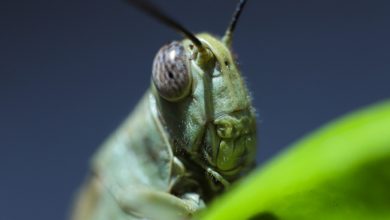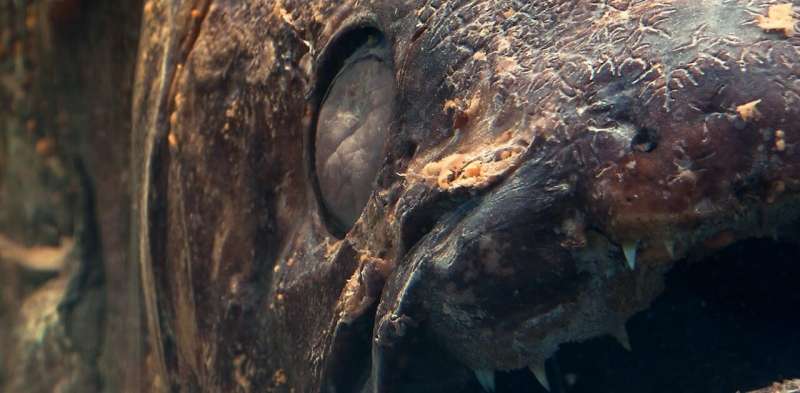
Credit: Shutterstock
We see evolution all around us, constantly, in every living thing. Yet, in the depths of the oceans, we find a number of “living fossils” reminiscent of creatures from prehistoric times.
In his 1859 book On the Origin of Species, esteemed naturalist Charles Darwin coined the term “living fossil” to describe living organisms that appeared unchanged from their extinct fossil relatives. The term has since been used to describe enduring lineages, relict populations, groups with low diversity, and groups whose DNA has changed little for millions of years.
The deep sea appears to be a good place for “living fossils”, with cartilaginous fish such as sharks and rays typically being 2-4 times more evolutionarily distinct than land animals. In other words, although each species is unique, these species are uniquely different from their closest relatives.
Let’s take a look at some of these relics from the past.
1. Coelacanth
Coelacanths are fish that live off the coasts of Africa and Indonesia. They have unusually shaped paired body fins that they move alternately, almost as if they were “walking” underwater. Their lineage dates back to the Devonian period, at least 410 million years ago.
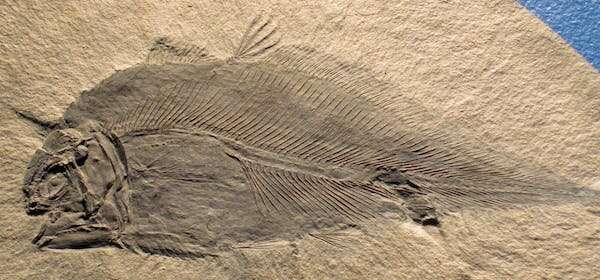
Allenypterus montanus, a fossil coelacanth fish from Bear Gulch limestone in Montana. Credit: James St. John
Coelacanths were once thought to have died out alongside (non-bird) dinosaurs around 70 million years ago, as they disappeared from the fossil record at that time.
So imagine the surprise when a living specimen was dredged from the depths of the ocean in 1938! This fish became known as “Old Fourlegs” and was considered the direct fish ancestor of all land animals (although we now know that’s not quite correct).
Today, there are two living species of coelacanths, known as Latimeria, which have remained virtually unchanged over the past 100 million years.
2. Horseshoe Crab
Horseshoe crabs are ancient creatures that first appeared at least 480 million years ago during the Ordovician period and don’t appear to have changed much since then. These are not crabs at all, but “chelicerae” and therefore closer to spiders and sea scorpions.
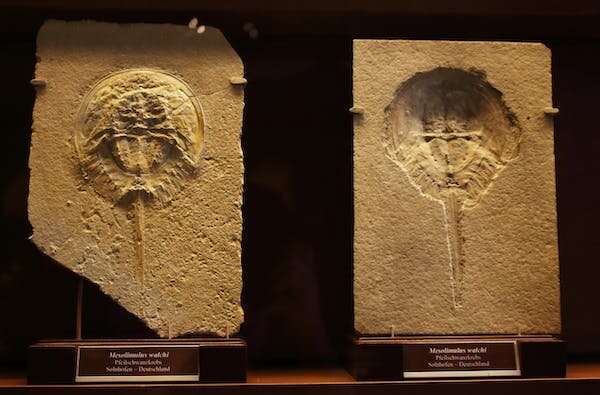
Mesolimulus walchi is an extinct species of horseshoe crab. Credit: Petr Hyks
There are four species alive today, all belonging to the family Limulidae, found in the waters off Asia and North America. They migrate to shallow coastal waters to breed in massive “orgy” events, with females laying several tens of thousands of eggs in the sand.
They also have a strange blue blood, colored that way due to a high copper content. Horseshoe crabs are harvested for their blood by the pharmaceutical industry as they are used in biomedical testing.
3. Elephant shark
Similar to horseshoe crabs, “elephant shark” (Callorhinchus milii) is a misnomer. This species, also known as the Australian ghost shark, is not a shark at all. It is a related type of cartilaginous fish known as a “chimera” and belongs to a subclass called Holocephali which diverged from the shark line over 450 million years ago.
These “plownose” chimaeras get their name from their oddly shaped snouts and can be found living off the continental shelves of Australia and New Zealand.
Analysis of their genome has shown that the species is changing at a veritable snail’s pace. In fact, it has the slowest evolving genome of any vertebrate, with its DNA almost imperceptibly altered over hundreds of millions of years.
4.Nautilus
Nautiluses are a type of marine cephalopod mollusk and are therefore related to squids and octopuses. However, unlike other cephalopods, they are housed in a distinctive smooth, hard shell.
Nautilus live in open water in and around coral reefs in the Indo-Pacific Ocean. They are hunted for their beautiful shells to make art and jewelry, but international trade is now regulated to protect them from overexploitation.
Members of the family Nautilidae are known to have existed since the Upper Triassic and appear to have remained relatively unchanged for over 200 million years. Darwin himself described these creatures as “living fossils”.
5. Goblin Shark
The goblin shark (Mitsukurina owstoni) is a bizarre animal with a long, flat snout and toothy jaws that protrude in front of the face to catch unsuspecting prey. It is a relatively rare deep-sea shark living in all major oceans. With a face only a mother could love, he was described as “grotesque” when first met in 1910.
The goblin shark is the only living representative of its family, the Mitsukurinidae, and is the most evolved shark known to us. its lineage dates back some 125 million years.
6. Mantis Shrimp
Mantis shrimp, also called stomatopods, are distinctive crustaceans found in tropical and subtropical coastal waters around the world. They are fearsome marine carnivores known to deliver an incredibly quick and painful blow.
They also lead a colorful life. During mating season, they fluoresce (glow light) and have complex eyes to watch these displays. In fact, they have up to 16 color receptors, while humans only have three.
The mantis shrimp lineage split off from other Malacostraca class crustaceans (such as crabs, lobsters, and krill) during the Carboniferous, around 340 million years ago. So these fabulous, fiery creatures have been blooming for a long time. Today there are hundreds of species belonging to the suborder Unipeltata, which appeared about 190 million years ago.
7. Striped Panray
Many cartilaginous fishes tend to be very evolutionarily distinct, but number one is the striped panray (Zanobatus schoenleinii). This fish has a median age of “evolutionary distinction” of 188 million years.
Today, the striped panray lives in the tropical waters of the eastern Atlantic Ocean (and possibly the Indian Ocean) and feeds on small invertebrates from the ocean floor. It belongs to the order Rhinopristiformes and is oviparous, that is to say, it gives birth to live young. It is listed as “vulnerable” by the International Union for Conservation of Nature.
8. Brachiopods
Brachiopods are shelly marine animals with long, fleshy stalks that live in burrows on the seabed. They act as reef-building organisms, feeding on the water around them. Brachiopods living today, like Lingula, more or less resemble their Cambrian counterparts from around 500 million years ago! They are considered the oldest known animal (genus) that still contains living representatives.
In The Origin of Species, Darwin noted “some of the oldest […] animals like […] Nautilus, Lingula, etc., do not differ much from living species.” It was these observations that led him to propose the term “living fossil”.
9. Crinoids
Crinoids have been known since at least the Devonian (359-419 million years ago) but may have existed as long ago as the Ordovician (over 445 million). These marine animals, also known as “sea lilies”, once lived on the seabed in a symbiotic relationship with corals. The corals grew on the stems of the crinoids to reach higher in the water column for better feeding opportunities.
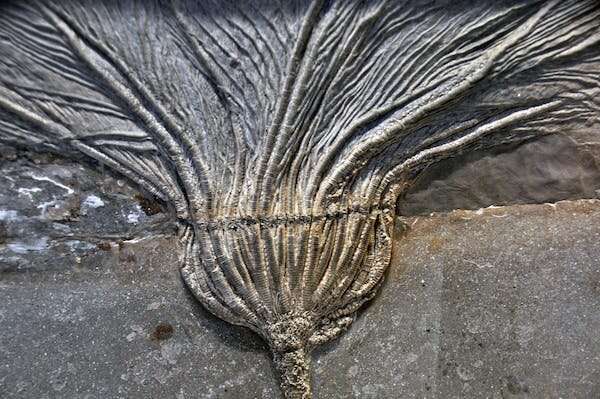
A species of fossil crinoid called Seirocrinus subangularis. Credit: James St. John
This association was very common until the supposed extinction of crinoids 273 million years ago. However, in 2021, these two sea creatures were rediscovered in Japanese waters, thriving in a happy aquatic partnership. It remains a mystery why no fossil evidence of this happy marriage has been found for the intervening period.
How are living fossils formed?
While animals described as “living fossils” generally continue to evolve, many of these changes are imperceptible to the human eye. To track the evolution of animals over time, we look at visible molecular changes in genes, or “morphological” changes in physical form.
Internal (or molecular) drivers include genetic drift, which is the random change in the frequency of genetic variants in a population over time. External forces include natural selection, especially sexual selection, which leads to the inheritance of specific traits in a population over time.
All marine animals on this list appear to be in morphological stasis (slowing down or stopping). Some may also have molecular stasis. Their slowed rates of evolution are likely the result of the relatively stable underwater environment, particularly in the open ocean. These remote refugia are among the least affected by direct human impacts and weather and climate change.
Again, these animals are not immune. And if we’re not careful, we risk losing some of these curious creatures forever.
Older than expected: teeth reveal the origin of the tiger shark
Provided by The Conversation
This article is republished from The Conversation under a Creative Commons license. Read the original article.![]()
Quote: From Coelacanths to Crinoids: These Nine ‘Living Fossils’ Haven’t Changed in Millions of Years (October 10, 2022) Retrieved October 10, 2022 from https://phys.org/news/2022-10-coelacanths- crinoids-fossils-havent-millions.html
This document is subject to copyright. Except for fair use for purposes of private study or research, no part may be reproduced without written permission. The content is provided for information only.
#Coelacanths #Crinoids #Living #Fossils #Havent #Changed #Millions #Years


